The Rise and Fall of Empires
This complete module with all materials may be downloaded as a PDF here.
Hunt Davidson
Chattanooga Christian School
Chattanooga, Tennessee
Editorâs note: Chattanooga Christian School History Department Chair Gary Lindley had the original idea that resulted in the development and implementation of this module.
This interdisciplinary module was developed and utilized for a ninth-grade civics and American government class. However, the content of the module is âhigh expectations,â and it can be utilized in high school standard or honors U.S. government or history classes. The module is intended for students who are near the end or about to complete a civics, U.S. government, or history class.
Estimated total time: Two to three fifty-minute classes
Overview
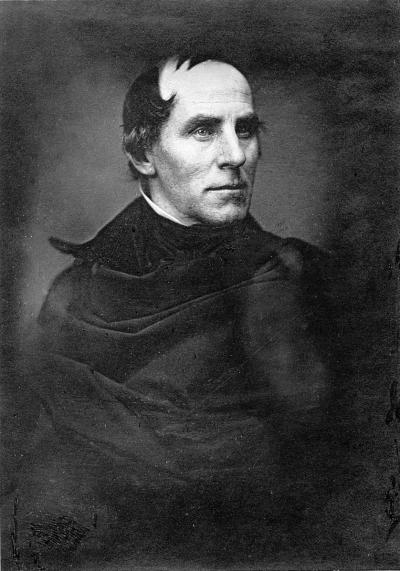
Thomas Cole. Source: Wikipedia at https://tinyurl.com/yd6hu9vl.
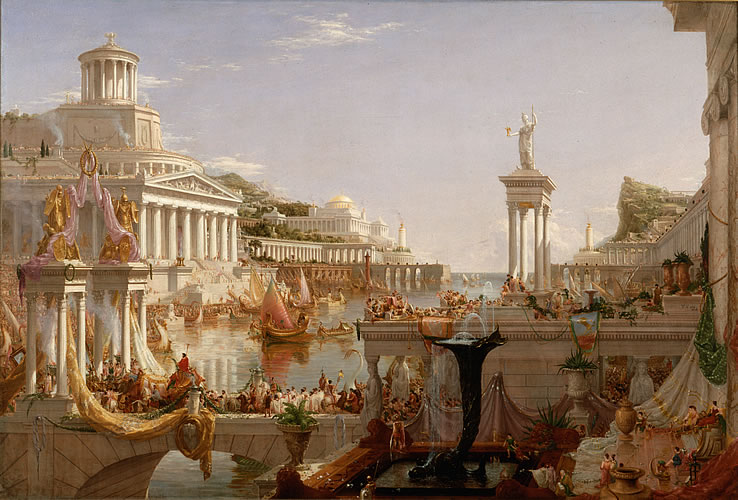
"The Consummation of Empire" by Thomas Cole. Source: Explore Thomas Cole at https://tinyurl.com/y8mkcnrf.
Why do empires rise? Why do they fall? Even the briefest survey of history will reveal the fact that no empire or great nation has permanently endured through the ages. Are there common characteristics that great nations and empires across time and space share in their rise and fall? American Founders, particularly those who were college graduates, with classical educations grounded in the study of antiquity recognized that no polity is immune from eventual decline and fall, but attempted to design a system that would preserve a republican form of government as long as possible. During this module, students will work with a series of paintings titled The Course of Empire by Thomas Cole (1801–1848), a noted American landscape artist. In the course of the module, students will consider Cole’s visual depiction of a cycle of history and use Cole’s ideas to reflect upon America’s past and its future.*
*(For the purposes of this module, although the terms “empire” and “great nation” are both used, the two are not necessarily synonymous, and teachers are encouraged to draw some distinction for students between the two terms. Empires have characteristically possessed colonies—e.g. the Roman Empire, Imperial China, or the British Empire—while great nations like the U.S. or contemporary China don’t have formal colonies, but because of military power and cultural and political influence exercise and even contest for geopolitical spheres of influence.)
Objectives
Students will:
Discuss and analyze various themes that, according to Cole, accompany the rise and fall of great civilizations.
Analyze the series of paintings The Course of Empire Thomas Cole painted between 1833 and 1836. utilizing three criteria: analysis of technique, exploration of historical context, and interpretation of themes and symbols.
Consider how in developing our present Constitution, some of the Founders attempted to construct a system that could effectively forestall national decline as long as possible.
Reflect upon what lessons Cole thought his paintings had for the U.S. in the 1830s and what lessons the paintings might have for contemporary Americans.
Prerequisite Knowledge
The assumption is that students will have no prior knowledge of Thomas Cole or his paintings. However, it is expected that they will be familiar with the generalization that nations do rise and fall, and to date, there is no evidence one nation’s particular political system has proven impervious to events and to time. Since this module is intended to be used near the conclusion of a school year, the expectation is that students will understand basic information about American history, the Constitution, and our political system.
Procedures Narrative
Editor’s note: This module is unique in certain respects in its use of civic and historical ideas through art and its seemingly open-ended but, in fact, structured approach. The author was requested to summarize student responses, and they appear occasionally in what follows. The paintings shown are available at http://www.explorethomascole.org/tour/items/63/series/. Teachers will need to use a compatible web browser with Adobe Flash Player to experience the full features of the site like pan and zoom with paintings.
Module introduction (class one)
Write or display the following questions on a whiteboard or overhead projector for students when entering the classroom:
What factors contribute to the rise of powerful nations and empires? Why, thus far in human history, has no great nation or empire managed to permanently avoid decline and fall? (Remind students that even powerful empires such as Imperial China or Egypt declined and eventually fell, even though today, both these nations again exist with different forms of government than in the past, as well as significant global or regional influence.)
Encourage students to articulate their responses and critique various cited factors raised by other class members. As the discussion progresses, write down any recurrent reasons students cite on a whiteboard or overhead (to be referenced later when Cole’s paintings are introduced).
An additional question that is optional is whether or not the U.S. is in the midst of a period of national decline relative to the nation’s past. Posing this question in my class has stimulated students' imagination and motivation for the activities that follow, but it is important if the question is utilized that students provide a rationale for particular positions, that teachers and students critique student assertions, and that the discussion time for the question be limited (estimated time, fifteen to twenty minutes).
Contemplating The Course of Empire series
Explain that a broad question such as why great empires and nations rise and fall can be investigated in many ways, but the class will think more about the question through exploring a series of five famous paintings called The Course of Empire by Thomas Cole. Do not provide contextual or historical information about Cole or the paintings at this juncture in the module.
Before looking at the paintings, ask the students to infer what Cole might be depicting in his paintings based just on the title The Course of Empire. Now, display each painting in sequential series order (available at http://www.explorethomascole.org/tour/items/63/series/).
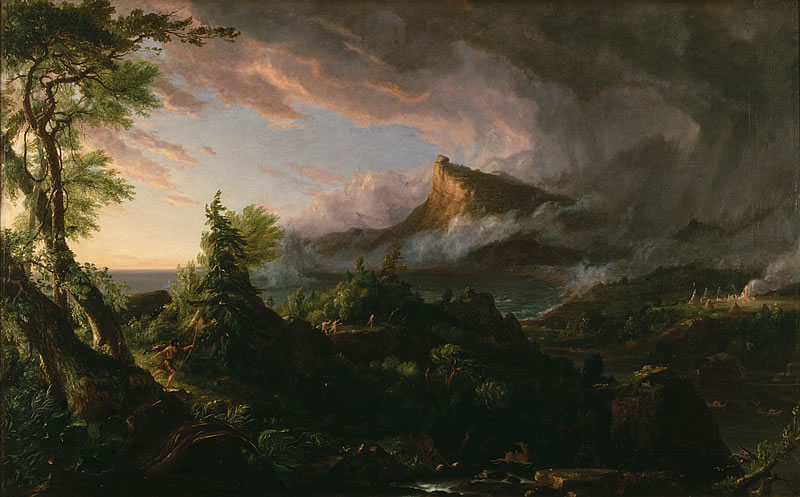
Painting 1, "The Savage State"
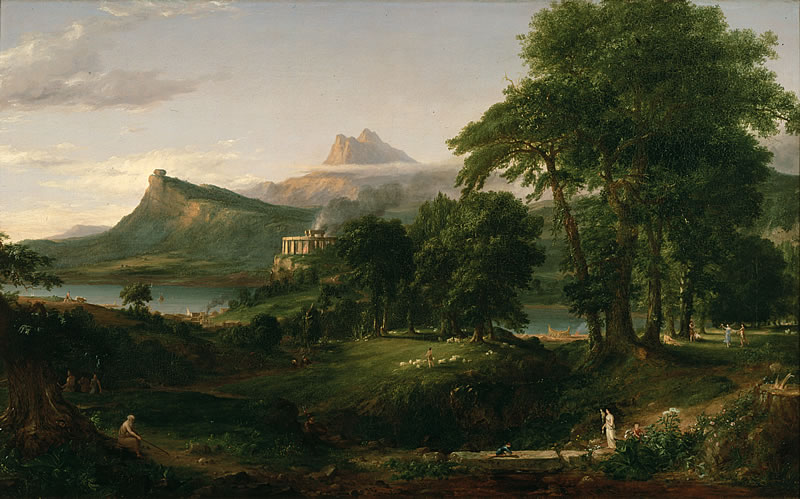
Painting 2, "The Arcadian or Pastoral State"

Painting 3, "The Consummation of Empire"
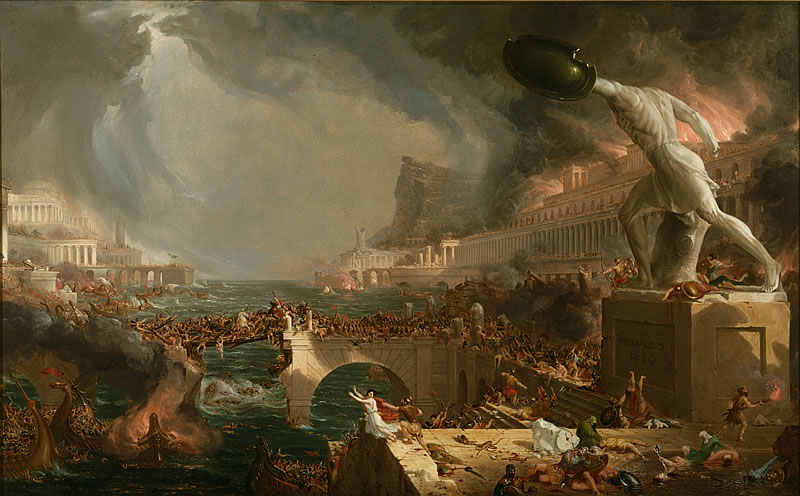
Painting 5, âDesolation"
Guide students through silent but systematic individual observations of each of the five paintings in the series, which will occur for the remainder of class one. Student observations lay the groundwork for both subsequent homework and the ensuing class discussion the following day. Have students spend approximately five minutes viewing each painting. Indicate to students that for each of the following paintings, they should spend one or two minutes simply carefully viewing, thinking, and reacting to the painting. Then, they should briefly note in writing as specifically as possible their reactions and thoughts about each painting after each separate viewing. Focusing questions you might want to use for this exercise include the following: What mood does the painting evoke? What is the painting literally depicting? What might it be symbolically be depicting?
(Authorâs note: The paintings are powerful in a unique way, and student fascination with the series was particularly enhanced when I zoomed in on different parts of a painting to introduce students to nuances they might have otherwise missed).
Near the end of class one, indicate to students that they are asked to complete a homework assignment that I hope will deepen their reflections about the paintings in the series and prepare the class for an extended discussion on the essential topic of their study. Distribute or have students access online an abridged version of Matthew Bristleyâs âHow to Analyze an Artistic Work.â Students will access the series again for homework at http://www.explorethomascole.org/tour/items/63/series/.
Students will again view the paintings, read a brief biography of Cole at http://thomascole.org/biography-of-thomas-cole/, and utilize the abridged âHow to Analyze an Artistic Workâ to write a one-to two-page response to the Course of Empire series based upon most of criterion in the document. Note: An abridged version of the original worksheet by Matthew Bristley is available at this link (estimated time, thirty minutes).
Class No. 2
Begin class by reading a quotation from the famous British Romantic poet Lord Byron (1788â1824), who profoundly influenced Cole to the extent that the artist used Byronâs lines to promote the series
(from Childe Haroldâs Pilgrimage, 1818):
There is the moral of all human tales;
'Tis but the same rehearsal of the past.
First freedom and then Glory â when that fails,
Wealth, vice, corruption â barbarism at last.
And History, with all her volumes vast,
Hath but one page...
Begin class by again asking an extension of the question posed the previous day: Why do great nations rise and fall? How do they rise and seemingly cannot last? Have students paraphrase or read their responses to the questions below from:
âHow to Analyze an Artistic Work.â
In the title
List the basic information of the piece: artistâs name, title, date, medium, size, and location. Example:
Botticelli, Primavera, 1482. Tempera on wood, 80 Ã 124 in. Uffizi Gallery, Florence. Michelangelo, David, 1504. Marble, 17 ft. Piazza della Signoria, Florence.
Introductory paragraph
What immediately catches your eye?
What is the subject matter (whatâs happening in the artwork)?
Is there a message? How is that message communicated to the viewer (briefly)?
Analysis of technique
Where is the light coming from in the painting/drawing and how is it used?
What is the perspective of the painting/drawing and how is that significant?
Historical context
What was going on in America when Cole painted this series?
Who do you think his intended audience was?
What do you think his intended message(s) was?
Authorâs notes on student reactions: With the knowledge of where Cole was from and when he lived, students are beginning to place this series of paintings within the context of American history. For example, one student said, âThe second painting ('The Arcadian or Pastoral State') reminds me a little of Thomas Jeffersonâs idealized, agrarian state, and the second-to-last painting ('Destruction') reminded me of his warning about cities and urbanization."
One student asked a very thought-provoking question, âI wonder how Cole would have altered his paintings if he had painted them after the Civil War?â Discussion at this point started to orient itself around a comparison with the Foundersâ hopes and fears of America (Jefferson in particular came up a good deal).
Now, have students negotiate the interpretation questions in the analysis worksheet that are critical for the concluding discussion for class two:
What was the artistâs intention with creating this work? Did he or she succeed?
How does the artwork make you feel? What is your reaction to it? Why do you react so?
Critical judgment: Is it good; is it true; is it beautiful? Why or why not?
After students respond, again revisit the foundational question by using the following or similar language: Based on your work with these paintings from Cole, how and why do nations become powerful, and how and why do they fall?
Authorâs note on studentsâ reactions: Because of our earlier study of governmental power in this course, students know the danger of centralized power. In light of that previous learning, students talked a great deal about the transition from âPastoralâ to âConsummation.â More particularly, students were very curious about the role that power played in these two paintings and, therefore, what the allocation of power says about why a nation would rise or fall. For example, one student observed that âPastoralâ did not seem to have a clear âkingâ or ruling class, while âConsummationâ certainly does. The class then spent a few minutes discussing what has happened to the locus of control/power between the two paintings and whether or not that was a good thing. One possibility here (that I used) would be to redirect conversation for a few minutes to this question: In our study of American history, what evidence can we point to that would show whether or not our nationâs government has become more or less powerful? What effects does this centralization have upon citizens?
End the discussion with a final question utilizing the following or similar language: In light of your work with the Cole series, where do you see the United States in this spectrum between birth, growth, decay, death? Do we fit any of the paintings particularly well? Do you see evidence we can use to support our claim(s)? Do you think this âcourse of empireâ is inevitable? Why or why not?
It is important to point out to students that Cole, like Thomas Jefferson, had what many would consider an overly romantic view of the virtues of agrarian, pastoral societies and a distrust of cities. If necessary, have students consider the costs as well as the benefits of forms of human organization that are similar to the views of Jefferson or Cole. Also, pose this question: Are cycles of history inevitable, or is the view they exist too narrow and an oversimplification?
Authorâs notes on studentsâ reactions: This was probably the studentsâ favorite part. Since there had been a full semester of learning about the founding of the country and lessons in citizenship, the students were very engaged with the question. One student said, âThe U.S. is clearly in the stage of âConsummation.ââ To this, another student respectfully responded: âHow can you say that with everything going on in our country today? If we arenât there already, we are definitely headed toward âDestructionâ because of our materialism and consumerism. Didnât you see that the religious symbol [the temple] in âDestructionâ was absent, after it had was born in âPastoralâ and grown to fruition in âConsummationâ?â This back-and-forth dialogue took the class in a good direction. The rest of class was spent in a vibrant discussion of this initial disagreement, followed by a discussion of what the proper response of citizens ought to be. Should that response change in light of where the nation is on the âthe courseâ? If so, how? This question is where the class ended.
Extension/enrichment activities
Editorâs note: Further work on Cole after the module is taught provides even more fruitful opportunities to extend this module, which is a major reason for the expansion of the two-day option to possibly three class periods. Pennsylvania Art Professor Robb Bomboy has an excellent documentary on the series called The Course of Empire: Thomas Coleâs Warning for America, available at:
http://youtu.be/tA2bnof3-D8. It draws on Coleâs journal and related scholarship to indicate that the artist was significantly troubled by the Andrew Jackson Presidency and presents some evidence that the monarch being crowned in âThe Consummation of Empireâ was symbolically representative of Jackson. Excerpts from the documentary or even a complete showing will definitely enrich learning in the module.
If a third class day is devoted to the module, it is highly recommended that instructors assign or utilize excerpts from Anthony Comegnaâs superb essay âArt as Ideas: Thomas Cole's The Course of Empire":
https://www.libertarianism.org/columns/art-ideas-thomas-coles-course-empire.
The author situates Cole as not only a landscape art pioneer but part of a new generation of New York-based artists and intellectuals, âThe New Americans,â who were attempting to create an authentic new American culture. Cole shared many of these views but was personally conservative and disposed toward the newly emerging Whig Party idea of ordered liberty.
Both the documentary and the essay stress the profound influence exerted upon Coleâs series by his emotional response to visiting the ruins of Ancient Rome and contemplation of where America seemed to be heading.
Assessment
This moduleâs major purpose is to make students who have a basic understanding of American history and government deeply consider such critical questions as the tension between freedom and authority, the effect of corruption on government, the relationship between power and its abuse, and the pitfalls an overemphasis on materialistic values impose on any political system. Discussion will necessarily be subjective, and in many instances, there are no narrowly correct answers to these profound questions. However, the conscientiousness with which students prepare homework and the quality and seriousness of their classroom discussion can be assessed.
References and Resources
http://www.explorethomascole.org/: This is a web project by the Thomas Cole National Historic Site dedicated to exploring and analyzing the work of the painter Thomas Cole.
http://thomascole.org/biography-of-thomas-cole/: This is a link to a biography of Thomas Cole by the Thomas Cole National Historic Site.
https://www.youtube.com/watch?v=tA2bnof3-D8: This is a link to the documentary The Course of Empire: Thomas Cole's Warning to America by Pennsylvania Art Professor Robb Bomboy on YouTube.
https://www.gilderlehrman.org/history-by-era/art-music-and-film/essays/natures-nation-hudson-river-school-and-american-landscape: This link takes readers to âNatureâs Nationâ: The Hudson River School and American Landscape Painting, 1825â1876 by Linda Ferber from the Gilder-Lehrman Institute.
https://www.libertarianism.org/columns/art-ideas-thomas-coles-course-empire: Anthony Comegnaâs essay âArt as Ideas: Thomas Cole's The Course of Empire" is available from the Libertarianism website.